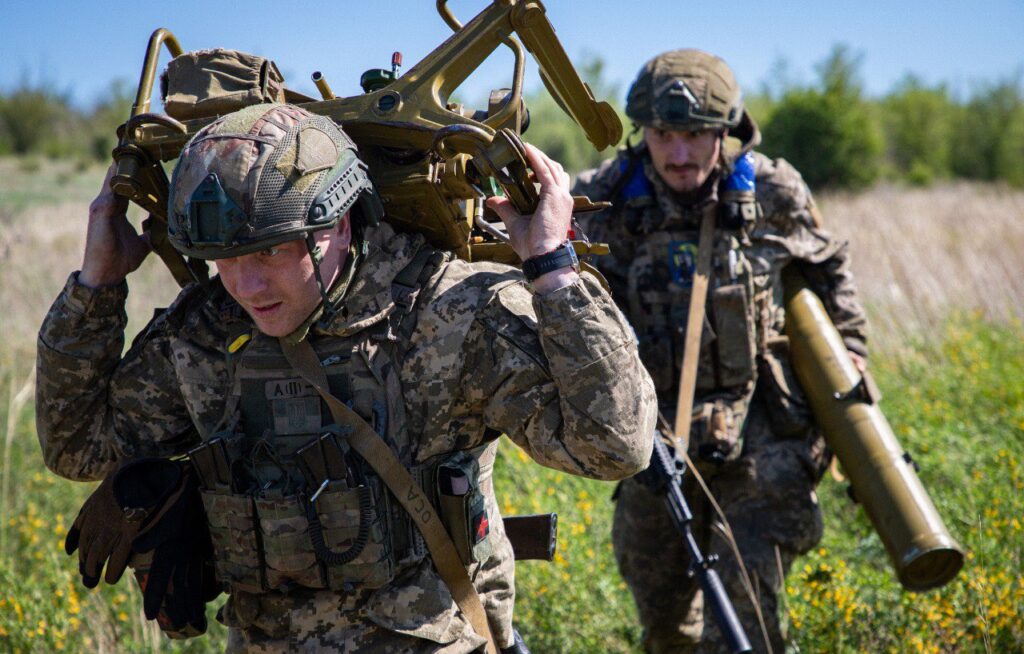A snapshot of recent news from sources around the world on the ongoing Russia-Ukraine war.

Political Developments
Ukrainian and European defense companies met in Brussels this week to discuss options for investing in Ukraine’s defense industry and potentially bolstering domestic production to help the war effort. Ukraine could potentially be building more weapons at home for use in the war, but a significant investment is required.
Moscow warned the U.K. government that Ukrainian strikes in Russian territory using U.K.-supplied weapons could result in retaliatory strikes on U.K. assets in Ukraine or elsewhere. Russia also said it would hold nuclear weapon simulation drills in response to Western support for Ukraine.
Chinese leader Xi Jinping pushed back against criticism of his lack of pressure on Russia to end the war in Ukraine. “We oppose the crisis being used to cast responsibility on a third country, sully its image and incite a new cold war,” he said during a visit to France.
Ukraine is using billboards and social media in a new recruiting drive to address a shortage of troops on the front lines. At least 31,000 Ukrainian soldiers have been killed since the start of the war, and units on the front are reporting exhaustion and a lack of personnel. At the same time, Russia is increasing its own use of social media apps like TikTok to spread misinformation and lower support for the war among Ukrainians.
Ukraine’s state security service said a plot to assassinate Ukrainian President Volodymyr Zelensky was thwarted. Two colonels serving in the State Guard of Ukraine were detained on suspicion of working with Russia’s Federal Security Service (FSB) to craft an assassination plan.
Military Assistance to Ukraine
U.S. National Security Advisor Jake Sullivan said the $61 billion in military aid recently approved by Congress would allow Ukraine to hold the lines against Russian forces until a new counteroffensive can be launched in 2025. However, Sullivan said additional funding will be required to support the counteroffensive. Russia is preparing its own offensive Kharkiv and Sumy regions, according to Ukraine’s military intelligence service.
The Pentagon announced a $400 million aid package for Ukraine Friday afternoon. The announcement reflects the 57th tranche of gear donated to Ukraine directly from U.S. inventories. The package includes Patriot, NASAMS, and Stinger air defense missiles; HIMARS ammunition and artillery rounds; Bradley and M113 armored vehicles, as well as Mine Resistant Ambush Protected Vehicles; and TOW, Javelin, and AT-4 anti-armor weapons, among other equipment.
E.U. Ambassadors have reached an agreement that could see the bloc provide dividends and interest from frozen Russian central bank assets to Ukraine, which could then be used to purchase military hardware and ammunition. Around EUR210 billion is frozen in the European financial system, which could yield around EUR3 billion annually.
The Estonian military held internal deliberations on the possibility of sending troops into western Ukraine to backfill non-combat roles for the Ukrainian Armed Forces, General Martin Herem, the commander of the Estonian Defence Forces, told Breaking Defense. Lithuanian Foreign Minister Gabrielius Landsbergis, meanwhile, threw his support behind the idea of a training mission operating on Ukrainian soil.
To date, however, European countries have not moved forward with deploying troops to Ukrainian soil. After reports circulated that Paris had put troops in the country, the French Foreign Ministry issued a denial on May 6, saying, “France has not sent troops to Ukraine.”
Czechia has reportedly delivered an F-16 simulator to Ukraine to assist with pilot training. Ukraine is expected to begin receiving the combat jets themselves in the coming months.
La Repubblica reported that Rome is planning to deliver a second SAMP/T air-defense system to Ukraine, in response to Kyiv’s requests for more surface-to-air systems to protect its troops and population centers.
Danish company MyDefense delivered over 100 Wingman 103 drone-detection devices to the Ukrainian military this week.
Battlefield Updates
A Ukrainian drone targeted Gazprom’s Neftekhim Salavat processing plant in the Russian Republic of Bashkortostan, some 1,400 kilometers away from the Ukrainian border. A Ukrainian source speaking to Reuters called the strike the longest-range attack that Kyiv has carried out since Russia’s invasion in February 2022.
Russia has performed another attack on Ukraine’s power generation network. The attack included 55 missiles and 21 drones against targets in the Lviv region of western Ukraine. DTEK is Ukraine’s largest private electricity company and said the attack caused “serious damage” on three of its six thermal power plants.
The Ukrainian military is suspected of using an ATACMS (Army Tactical Missile System) in an attack on a Russian oil depot. The attack struck Luhansk, a city in eastern Ukraine, on May 7. Officials with the Luhansk People’s Republic (LNR) said Ukraine used the ATACMS in this operation.
Heavy Russian equipment losses in Ukraine are straining their stocks, raising concerns about replacing aging Soviet-era vehicles.
Russia has modified some Kh-101 cruise missiles by adding a second fragmentation warhead. The modification increases weight and reduces the missile’s range, but it makes the weapon more destructive.
For 50 years, Forecast International intelligence reports have been the aerospace and defense industry standard for accurate research, analysis, and projections. Our experienced analysts compile, evaluate, and present accurate data for decision makers. FI's market research reports offer concise analysis of individual programs and identify market opportunities. Each report includes a program overview, detailed statistics, recent developments and a competitive analysis, culminating in production forecasts spanning 10 or 15 years. Let our market intelligence reports be a key part of reducing uncertainties and mastering your specific market and its growth potential. Find out more at www.forecastinternational.com



